Paul Manley Back Pain and RSI Clinic
Paul Manley, M.A.O.(Manip), Registered OsteomyologistFor muscle and joint problems

RSM (Royal Society of Medicine)
Specialist in the treatment of Musculo-skeletal problems
Location: 8-10 Boston Place, Marylebone, London NW1 6QH
Next to Marylebone Station, Main line trains and Bakerloo line
19/01/2026
The Thumb joint and Thenar Eminence Syndrome.
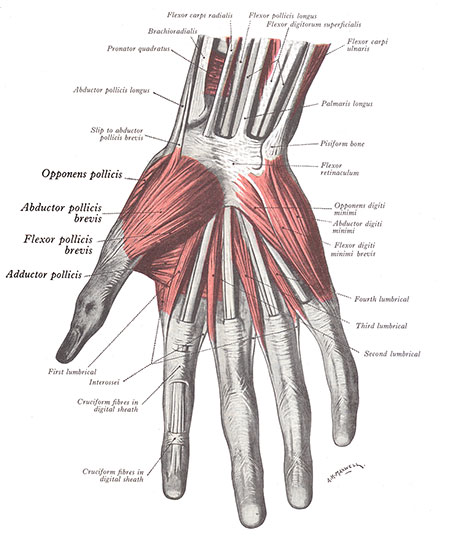
Figure 1.
The muscles (in bold) are the ones most affected by hypertonus. They will feel very hard when squeezed.
( See also figures 5 +6).
This type of problem is very common. It especially affects people who use or over-usetheir thumbs in gripping and squeezing activities such as needlework, writing, playing musical instruments, gardening, playing darts (Dartitis) and many other similar activities. It affects females far more than males. especially during the menopause.
The thumb muscles can become 'rock-hard' over time. As a consequence the thumb joint at the base will suffer greatly. Functions of the thumb become progressively weaker and the joints become more easily inflammed and injured. Simple things like opening a jar or turning a door handle can be a painful problem.
With each prolonged period of inflammation, the more the joint will change shape by 'splaying' outwards. It will usually begin by leaving behind a bony nodule or bump, most often on the middle knuckle.
One must bear in mind that because ligaments attach to these, now distorted, surfaces, they will not be at an appropriate tension to do their job properly.
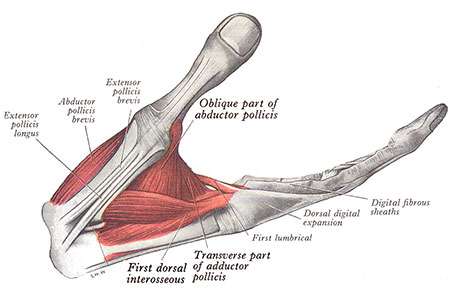
Figure 2.
The muscles most affected in Thenar Eminence syndrome.
(In bold)
Trauma to the joint most often occurs when the joint is bent backwards suddenly. Often a fall onto the hand in an awkward position will sprain the joint. Sometimes skiers will get their ski pole stuck or it will twist in their grip, the thumb being restrained within the strap of the pole, the thumb is violently bent backwards. A knock to the base of the thumb or to the middle part of the palm surface of the thumb will produce a bruising which is often not visible but which can be very painful and take quite a long time to heal. Car accidents where the thumb is gripping the steering wheel and takes the full force of impact will be badly injured, sometimes causing a chip of bone to come loose. This is called an avulsion fracture. Most often I deal with the muscular and ligamentous/joint related causes of this syndrome, although I can help greatly with recovery in traumatic cases.
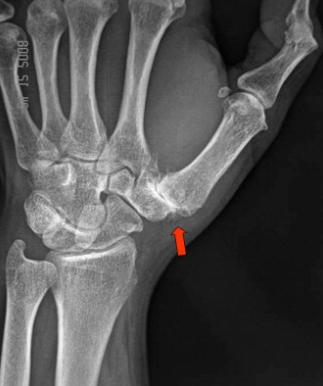
Figure 3.
Arthritis of the Carpo-metacarpal joint of the thumb.
Figure 4.
Flexion and extension of the thumb joint.
There are a few ways to combat the build up of what begins as simple muscle tension. If you have the strength grip the thenar eminence in a 'pincer' hold. Explore the areas within your grip. Feel for tough, painful areas of muscle and then rhythmically squeeze them between your gripping hand. In the illustrations below I am squeezing with my right hand.
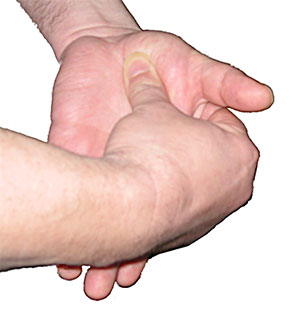
Figures 5 and 6.
Grip and squeeze rhythmically.
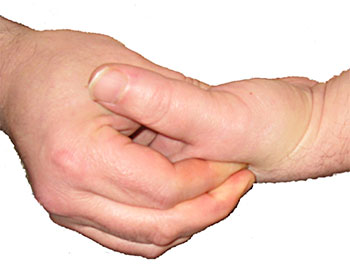
Note that the middle finger of my right hand is pressing onto my index finger to give additional pressure strength.
There are many other techniques which will be beneficial to this problem, but which are a little too complex to be shown here. Plus, I wouldn't want you to get them wrong and end up irritating the area.
If you can get to see me, give me a call and I will examine and treat these disabling syndromes. Even if the joint seems to have been affected and its appearance on X-ray is not too good, I can still help a lot.
07925 616 753
Location: 8-10 Boston Place, Marylebone, London NW1 6QH
Next to Marylebone Station, Main line trains and Bakerloo line